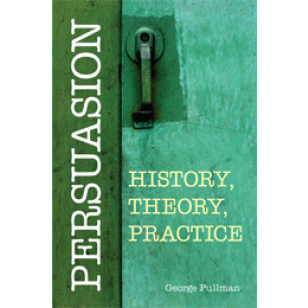Persuasion: History, Theory, Practice
George Pullman's lively and accessible introduction to the study of persuasion is an ideal text for use in courses where the understanding and practice of argumentation, rhetoric, and critical thinking are central.
"George Pullman's Persuasion has much to commend, not only in its direct engagement of the rich tradition of rhetoric, but also in its well-chosen range of readings (from the Greek tradition as well as contemporary pieces) and exercises in each chapter. In particular, I liked the way the introductory material invites experienced and newer students to consider the value of effective communication in professional settings. The exercises not only enable students to put into practice the key ideas highlighted in the chapter, but also promote digital literacies, which are fundamental in the twenty-first century. Students will find chapters three and four especially valuable for their clarity in explaining topics, issue types and use of evidence. Finally, this is an affordable and relevant classroom text that students will be able to consult long after the course of study has ended." —Cecilia Bonnor, Department of English, University of Houston
Title Support Website: Persuasion: History, Theory, Practice Title Support Site.
eBook available for $23.95. Click HERE for more information about Hackett eBooks.
George Pullman's lively and accessible introduction to the study of persuasion is an ideal text for use in courses where the understanding and practice of argumentation, rhetoric, and critical thinking are central.
Continually challenging his readers to seek and recognize sound evidence, to question the obvious, and to assess and reassess the credibility of claims made by others—including the author's own—Pullman shows the way to strong writing, effective speaking, and rigorous critical thinking.
Persuasion: History, Theory, Practice provides:
- An overview of the traditional canons of rhetoric, along with updated versions for contemporary communication practices.
- Strategies for honing persuasive skills.
- Guidelines for creating persuasive arguments and for critically evaluating the arguments of others.
- A wealth of exercises—including activities appropriate for group participation—that can be assigned or used for self-testing and practice.
- Guidelines for the writing of argumentative papers.
- A section on decision-making.
- Selected classical readings on rhetoric and persuasion.
- A glossary of important terms.
- Suggestions for further reading.
Additional Resources:
View the Table of Contents (PDF): Table of Contents for Persuasion: History, Theory, Practice.
Title Support Website: Persuasion: History, Theory, Practice Title Support Site.
Reviews:
"George Pullman's Persuasion has much to commend, not only in its direct engagement of the rich tradition of rhetoric, but also in its well-chosen range of readings (from the Greek tradition as well as contemporary pieces) and exercises in each chapter. In particular, I liked the way the introductory material invites experienced and newer students to consider the value of effective communication in professional settings. The exercises not only enable students to put into practice the key ideas highlighted in the chapter, but also promote digital literacies, which are fundamental in the twenty-first century. Students will find chapters three and four especially valuable for their clarity in explaining topics, issue types and use of evidence. Finally, this is an affordable and relevant classroom text that students will be able to consult long after the course of study has ended."
—Cecilia Bonnor, Department of English, University of Houston
About the Author:
George Pullman is Associate Professor of Rhetoric and Director of the Center for Instructional Innovation at Georgia State University.












